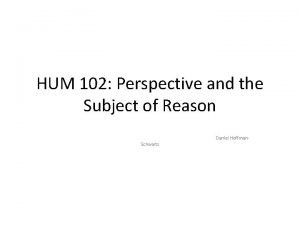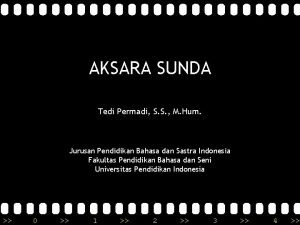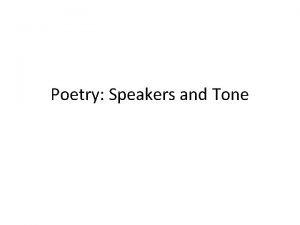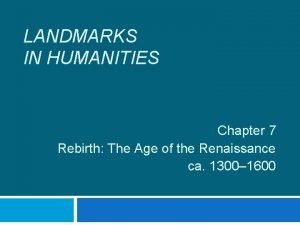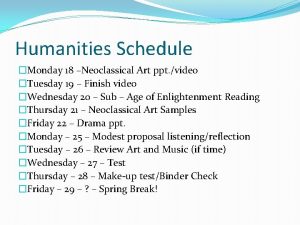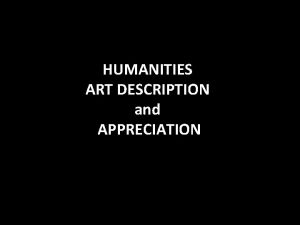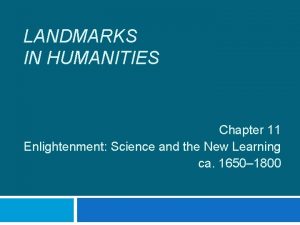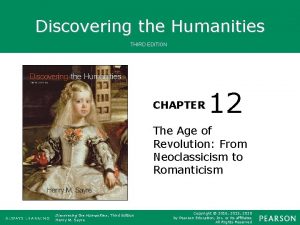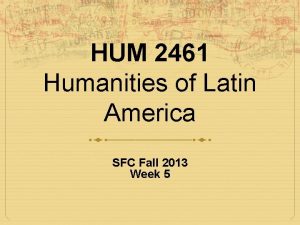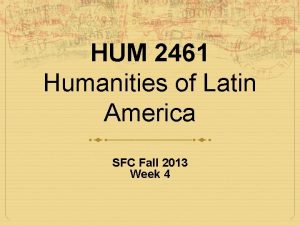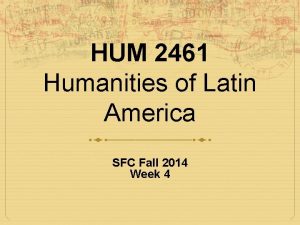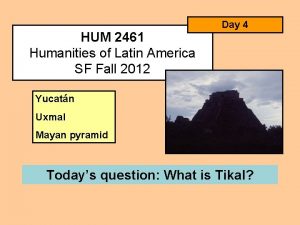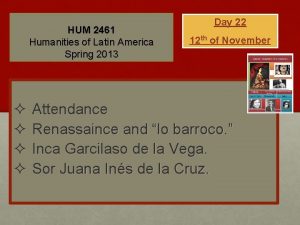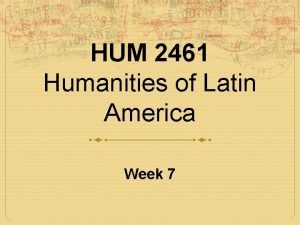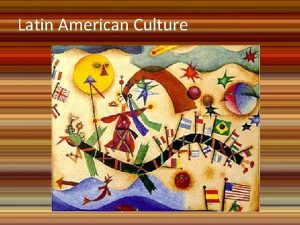HUM 2461 Humanities of Latin America Fall 2014






































- Slides: 38

HUM 2461 Humanities of Latin America Fall 2014 ² Attendance ² Renassaince and “lo barroco” in Sor Juana Inés de la Cruz. ² POP QUIZ

Sor juan inés de la cruz Aztec Empire Mesoamérica México

lo barroco in mexico ²A profusion of adornment in all the arts, and ²A complicated façades, abundant foliage, plaster darts, crossings, coiling, scrolls, and conical shapes mixed with traditional shapes in sculpture and architecture.

characteristics of lo barroco in literature ² Extreme decoration ² Subtle conceits (clever plays on words): language is “slippery ground” ² Maximum culture (knowledge, all the reading of humanities) ² Pessimism ² Metaphor ² Stark opposites (light/dark) ² Veras and burlas

METAPHOR ²A figure of speech in which a word or phrase that ordinarily designates one thing is used to designate another, thus making an implicit comparison, as in "a sea of troubles" or "All the world's a stage" (Shakespeare). ²Which is your? , get a piece of paper and write down a metaphor!

Veras & burlas

Veras & burlas THE CREST THE COPLA

Sor juana inés de la cruz (17 th century) ²Juana de Asbaje y Ramírez ²Sor Juana ²México, nov. 12 th, 1651 April 17 th, 1695 ²Writer and poet.

1651 - 1695 / San Miguel Nepantla / Mexico

Two main contributions 1. Against the role of church. Expressed in prose, mainly. 1. Against patriarchal societies. Expressed in poetry.

Most important literary work ²Sor Juana Inés de la Cruz was an exceptional XVII-century nun who set precedents for feminism long before the term or concept existed. ²Her defense (letter) "Respuesta a Sor Filotea” (Reply to Sister Philothea) is a maverick work outlining the logical sense of women’s education more than 200 years before Virginia Woolf’s “A Room of One’s Own. ”

Most important literary work IN POETRY: ²Her poetry, meanwhile, states in bold language the potency of the feminine in both love and religion. ²Poems such as “You Men” and “First Dream” pointed out how women were mistreated by men and society.

1) Against the role of church: “Respuesta a sor filotea” What is “Respuesta a Sor Filotea”? It is an answer to the Bishop of Puebla (México), Fray Manuel Fernández de Santa Cruz, defending herself.

1) Against the role of church: “Respuesta a sor filotea” What is “Respuesta a Sor Filotea”? Sor Juana critiques a famous sermon given — 40 years earlier— by the eminent Portuguese Jesuit, Antonio de Vieira (Baroque Brazil)

1) Against the role of church: “Respuesta a sor filotea” ² Sor Juana writes —by Fray Manuel Fernández request— “Carta atenagérica” ² Fray Manuel Fernández also includes a letter of his own titled “Missive Worthy of Athena. ” (1691) ² In the letter he is admonishing Sor Juana for her intellectualism under the pen name Sor Philothea de la Cruz.

Fragments of “respuesta a sor filotea” 1. The publication of my work is a blessing which makes me feel unworthy. 2. I can’t thank you because I don’t know how, not because I’m ungrateful. I want to benefit more from your goodness; you can help to shape my intellect. 3. But your kindness does prompt me to answer, and I understand your warning to be against my secular writings. But how should I write of sacred things if I might misunderstand them? I don’t study to write or teach but to be less

Fragments of “respuesta a sor filotea” 4. How much harm would be avoided in our country if older women were as learned as Laeta and knew how to teach in the way Saint Paul and my Father Saint Jerome direct! 5. Instead of which, if fathers wish to educate their daughters beyond what is customary, for want of trained older women and on account of the extreme negligence which has become women's sad lot, since well-educated older women are unavailable, they are obliged to bring in men teachers to give instruction…

Fragments of “respuesta a sor filotea” 6. As a result of this, many fathers prefer leaving their daughters in a barbaric, uncultivated state to exposing them to an evident danger such a familiarity with men breeds.

Some points 1. Laeta’s knowledge Be able to learn (women can have knowledge as Laeta). 2. Saint Paul and Father Saint Jerome be able to teach (women can teach women). 3. Uneducated women Ignorance is dangerous. 4. Women become an easy prey Opens discussion over rape.

Last lines of “respuesta…” 57. And if you say I shouldn’t write poetry because I am a woman, you are saying the evil is in my being a woman – because there is no evil in poetry. Besides, I’ve only written when begged to by others. Even the piece you respond to [the prose critique] was not written by my own volition and I did not intend someone like you to ever read it.

Last lines of “respuesta…” 57. It has been criticized, but I deem it better not to defend it, because the truth will speak for itself. Praise is more harmful than criticism, anyway, as it tempts one to pride. 58. I will ask your correction of any further writing I do. 59. I hope I have not been too familiar. 60. I request God’s blessings on you.

Conclusions for “RESPUESTA…” ²Sor Juana turned around the logic used by the Church to justify her oppression and subverted it into a magnificent defense for women's intellectual rights and education.

Conclusions for “RESPUESTA…” ²Though the letter’s tone is superficially humble, Sor Juana forcefully insists that women have a natural right to the mind. Her use of biblical evidence to support her call for strong, educated women is downright clever -- and has earned her recognition for her rhetorical skills.

Conclusions for “RESPUESTA…” ² “Respuesta a Sor Filotea” brought indignation from the Church and unwanted attention from the Inquisition. ² To save herself, Sor Juana was forced to stop writing and to give up her books.

Characteristics of baroque On her writing (? ) On her life (? ) On her attitude (? )

2) Against patriarchal societies. through POETRY: “YOU men” Hombres necios que acusáis a la mujer sin razón, sin ver que sois la ocasión de lo mismo que culpáis: si con ansia sin igual solicitáis su desdén, ¿por qué quereis que obren bien si las incitáis al mal? Combatís su resistencia y luego, con gravedad, decís que fue liviandad Silly, you men-so very adept at wrongly faulting womankind, not seeing you're alone to blame for faults you plant in woman's mind. After you've won by urgent plea the right to tarnish her good name, you still expect her to behave— you, that coaxed her into shame. You batter her resistance down and then, all righteousness, proclaim that feminine frivolity,

“YOU men” Pues ¿para qué os espantáis de la culpa que tenéis? So why are you men all so stunned Queredlas cual las hacéis at the thought you're all guilty o hacedlas cual las buscáis. alike? Dejad de solicitar, y después, con más razón, acusaréis la afición de la que os fuere a rogar. Bien con muchas armas fundo que lidia vuestra arrogancia, pues en promesa e instancia Either like them for what you've made them or make of them what you can like. If you'd give up pursuing them, you'd discover, without a doubt, you've a stronger case to make against those who seek you out. I well know what powerful arms you wield in pressing for evil: your arrogance is allied

Dream vision DREAM ALLEGORY ² Emerged as a poetic genre in the Middle Ages. ² Kind of narrative. ² Narrator falls asleep and dreams the events of the tale. ² The story is often a kind of allegory a tour of some marvelous realm. ² Dante Alighieri The Divine Comedy (c. 1320) ² The dream vision was much favored by medieval poets, most of them influenced by the 13 th‐century Roman de la rose by the French poets Guillaume de Lorris and Jean de Meung.

First Dream, 1692 Primero sueño ² Her most celebrated work. ² Silva (a poetic form combining verses of 7 and 11 syllables) ² Describes through the form of a dream the soul's rising toward knowledge, employing extensively Sor Juana's knowledge of the sciences. ² The poem is baroque style, yet seems to foreshadow the Enlightenment in its scientifically oriented worldview. ² Interpretations of ”Primero sueño” are diverse. It has been variously described as metaphysical, as a defense of the private viewpoint, and as a work that in outlook foreshadows modern Mexican nihilism. ² Regardless of interpretation, it is perhaps her most important piece, particularly because of her claim that it was the only work she composed on her own impulse rather than at the request of another.

Spanish poets leading topics similar to hers: death • Jorge Manrique (1440 -1479) • “Coplas por la muerte de su padre”/ “Stanzas on his father’s death” Recuerde el alma dormida, avive el seso y despierte contemplando co mo se pasa la vida, co mo se viene la muerte tan callando, cua n presto se va el placer, co mo, despue s de acordado, da dolor; co mo, a nuestro parecer, cualquiera tiempo pasado fue mejor.

Spanish poets leading topics similar to hers: death • “Stanzas on his father’s death” Let from its dream the soul awaken, And reason mark with open eyes The scene unfolding, — How lightly life away is taken, How cometh Death in stealthy guise, — At last beholding; What swiftness hath the flight of pleasure That, once attained, seems nothing more Than respite cold; How fain is memory to measure Each latter day inferior To those of old.

Spanish poets leading topics similar to hers: dream • *Luis de Góngora y Argote (1561 -1627) • “A un sueño”/”A dream” El sueño (autor de representaciones), En su teatro, sobre el viento armado, Sombras suele vestir de bulto bello. Síguele; mostrárate el rostro amado, Y engañarán un rato tus pasiones Dos bienes, que serán dormir y vello.

Spanish poets leading topics similar to hers: dream • “A un sueño”/”A dream” The Dream (author of representations), In theater, on the wind armed Shadows usually wear beautiful package. Follow him; mostraráte the beloved face,

Spanish poets leading topics similar to hers: dream • *Pedro Calderón de la Barca (1600 -81) • “La vida es sueño” (Life is a Dream) ¿Qué es la vida? Un frenesí. ¿Qué es la vida? Una ilusión, una sombra, una ficción, y el mayor bien es pequeño; que toda la vida es sueño, y los sueños, sueños son.

Spanish poets leading topics similar to hers: dream • “Life is a Dream” What is life? A madness. What is life? An illusion, a shadow, a story. And the greatest good is little enough; for all life is a dream, and dreams themselves are only

What do you think el inca garcilaso and sor juana have in common? ²Illustrated foreigners. ²Belong to the Renaissance period, but live under a ruled society (Spain in México). ²Educated writers. ²No position in the patriarchal world.

Pop quiz 1. What is “lo barroco” in México? 2. Who is the maximum exponent in literature? 3. What does she represent? 4. What did she write? 5. Which work of hers caused her exile in literature?

 Why is called latin america
Why is called latin america Sfc-2461
Sfc-2461 Dr. lukman, s.t., m.hum.
Dr. lukman, s.t., m.hum. Abe hum pen thin height
Abe hum pen thin height Hum 102
Hum 102 Karotis manevrası yapmak
Karotis manevrası yapmak What is humanities in art appreciation
What is humanities in art appreciation Ho hum when he's finished pecking cartoon meaning
Ho hum when he's finished pecking cartoon meaning Alice hum
Alice hum Oh so hum
Oh so hum Mkm m
Mkm m Cada hum soldado he cidadão mormente os homens pardos
Cada hum soldado he cidadão mormente os homens pardos Hum schulen
Hum schulen Aksara sunda pamingkal
Aksara sunda pamingkal The speaker of a poem
The speaker of a poem Hum 102
Hum 102 Hum schultyp
Hum schultyp America 2 europe
America 2 europe Repetition in let america be america again
Repetition in let america be america again Happening body art
Happening body art We can do a rap of the map of the us
We can do a rap of the map of the us Ihsst
Ihsst Humanities through the arts
Humanities through the arts Art and humanities endorsement
Art and humanities endorsement College of humanities and social sciences
College of humanities and social sciences Digital humanities
Digital humanities Humanities subjects
Humanities subjects Where was the early renaissance (ca. 1400-1490) centered?
Where was the early renaissance (ca. 1400-1490) centered? Humanities art appreciation ppt
Humanities art appreciation ppt Charles university faculty of humanities
Charles university faculty of humanities Composed primarily to be sung.
Composed primarily to be sung. Historical development of humanities
Historical development of humanities Arts and humanities endorsement
Arts and humanities endorsement Humanities essay
Humanities essay Landmarks in humanities
Landmarks in humanities Introduction to humanities ppt
Introduction to humanities ppt Local guide program
Local guide program Discovering the humanities 4th edition
Discovering the humanities 4th edition Ca humanities
Ca humanities




